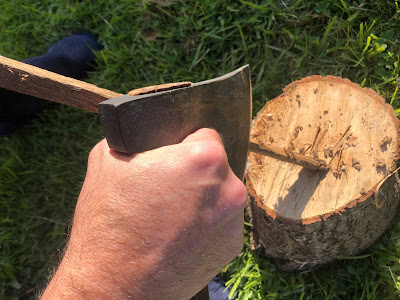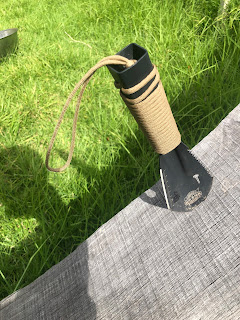I'm a notoriously difficult present recipient, mostly because I like eclectic and specialized kit and often get my own. When my birthday rolled around this year I was in the fortunate position to have made a list of cool things that I had not yet acquired. One such item was the flat packing and portable fire place system called a
Fire Box Stove. This is the Gen2 5" Folding Firebox Campfire Stove which is a multi-purpose super tool for fire.Thanks Basse and Barry!
It's a multi-fuel cook stove designed to be able to utilize wood and other fuels found in nature, solid fuel tablets, alcohol burners, iso-butane gas burners, gel fuels (
such as Sterno), wood pellets or charcoal briquettes. I haven't yet tried it but i'd think pine cones would work nicely in it, as would shredded or twisted cardboard.
The folding Firebox's large size and its sturdy construction makes it reportedly stable enough for a large dutch oven yet it can be used with cookware as small as a camping cup. BE sure to set it up on stable flat ground to avoid spilling your pot of
'pocalypse stew ... The Folding Firebox Stove is also easy to set up. It's four hinged sides effortlessly opens into position, the internal fire base folds down to lock it into its approximate box shape and the accessory fire sticks and ash-tray slot into place as desired. When it's time to go it folds flat, clips together and slips into its own handy leather case ready to slide into your pack, cleanly and easily.
Constructed of Stainless Steel, it stands 19cm(7.5") tall, 12.7cm(5.0")
across when set up and all told weighs 907g 92 lbs). Folded it lays a
mere 0.95cm (0.375") thick. The hinges are well enclosed longways loops
of rolled steel and steel pins. I found the hinges to be smooth and
whilst not stiff, to be firm enough that the walls did not flop around
when setting it up.


When the internal base is deployed , it braces the walls and fits it securely. Even after use, the hinges moves smoothly. The ash tray was a bit fiddly to fit but it has a right way and a wrong way, as its not square and neither is the stove. (It's a trapezoid.) The fire sticks either slots through the walls of the stove to offer coal support or into notches in the top to provide stable cook surface.

A perforated grill plate can also be fitted into the top of the stove in place of the fire sticks. This allows food to be directly cooked on the fire, without need of pot or pan but also makes good cooking platform for a pot or pan.
As well as the perforated sides which give good aeration and wind shielding a fold down lip at the top of one side gives when more heat and burn control. Fuel can be fed in through this gap or through the larger holes in the base of the walls. Short sticks, twigs even straw can be fed in though these side slots without having to remove cooking items from the heat. The relativity small size of the stove means that only a small volume of fuel can be loaded in at any one time so no big logs for long slow nighttime burns and it will require constant feeding. The Firestick posts made good fire tending tools and allowed me to lift and shift components such as flaps and the grill plate without burning myself.

The modular design of the FireBox means that a variety of fuel can be used, in a variety of amounts and applied to a variety of cooking methods. My only complaints with the design are that some of the tolerances are very tight, such as the holding pegs of the grill plate which can be; fiddly to seat and popped loose under heat.
A fire chimney isn't new to my firemaking kit. Astute readers may recall the
CampMaid charcoal chimney fire starting system I covered. In principle the two are every similar but the Firebox is purpose built as a stove, whereas the CampMaid chimney is designed as a BBQ starter.

With its multiple cooking configurations, useful accessories and collapsible design, the Firebox leverages its lightweight design and sturdy materials it can use virtually any size cookware and make use of some pretty marginal fuel sources to not only cook food, boil water to make safe but it also functions as a portable campfire.
It's small, not for for burning logs but it certainly beats trying to clear a dry spot for a fire after a rain, and preparing a fire pit, or leaving one improperly quenched. The Fire box, being so well vented, burns very completely leaving only fine ash if left to burn out.

As a backyard stove, it was excellent, and meant I could set up a small fire in a controlled way to burn off scraps and have some fun with my little one Tactical Baby, and teach her good fire behavior in a controlled space. In a wilderness setting it might be wise to set it up with some wind shelter, as the perforated sides and base let embers fall through and it would be irresponsible to spread fire, also it shelters the fire and ensures an even burn essential for cooking.
I used my
EverFire brick firestarters to both get it going and to do some initial cooking and it worked really well with those. The Firesticks allowed me to tailor the burn height and positioning. With these to maximize their effectiveness.

I noted a little warping of the grill plate after its first use, and some thermal discoloration of the steel from
where the stainless steel reached sufficient temperatures. Not that this was a surprise or is a problem but good to remember.
Its a little too big to fit in a cargo pocket, but small enough to fit in the front pouch of almost any daypack i'd want to take on the trail with me.
I look forwards to
collecting the accessories and trying out my lightweight camp cooking skills.
 |
| with an Everfire brick as fuel. supported by Firesticks |
 |
| Off cuts and woodwork scraps kindled by the EverFire brick |
 |
| time for a nice mug of tea! |
 |
| Baby wieners toasted and consumed! Vacation fun! |
 |
| Non-sqaure base plate folds to holds it rigid |
 |
| A single methylated spirit charged EverFire brick gets it red hot |
 |
| Heat your tea, cook your dinner, warm your hands! |

 Side flaps open all the way with heavy duty zippers on both sides, allowing easy access for either person ( as its a double) and bug-proof mesh with full zippers round out the build. Set up, the Swag is a spacious 2.15m (7') long and over 1.55m (5'1") wide, at the peak of its arc it is 96cm (3'1") high. Internally, both head and foot ends have a zippable window panel, behind more bug-mesh, and under storm flaps, allowing good airflow without compromising comfort. The real selling point for me, beyond the large footprint, was the included mattress. The ripstop fabric covered and free-floating pad is 7cm (2.75") thick, fully expanded. It's so comfortable.
Side flaps open all the way with heavy duty zippers on both sides, allowing easy access for either person ( as its a double) and bug-proof mesh with full zippers round out the build. Set up, the Swag is a spacious 2.15m (7') long and over 1.55m (5'1") wide, at the peak of its arc it is 96cm (3'1") high. Internally, both head and foot ends have a zippable window panel, behind more bug-mesh, and under storm flaps, allowing good airflow without compromising comfort. The real selling point for me, beyond the large footprint, was the included mattress. The ripstop fabric covered and free-floating pad is 7cm (2.75") thick, fully expanded. It's so comfortable.  Not only was it soft and padded, it also breathed and I could lay on it without matt or blanket without getting sweaty. The ceiling has loops for tying up the side flaps if they are up, but when down they serve as good tie-in points for a lamp or in my case to store my glasses whilst sleeping.
Not only was it soft and padded, it also breathed and I could lay on it without matt or blanket without getting sweaty. The ceiling has loops for tying up the side flaps if they are up, but when down they serve as good tie-in points for a lamp or in my case to store my glasses whilst sleeping.  The swag only weighed 14kg, so its no trial to carry, even with the regular camping load, but once home I found I could double it over and roll it up to make a much more manageable bundle at 80 cm long x 50 cm across. This was possible with the built-in straps and double-D-shackle binders. The bundle was thus smaller and more manageable to transport and pack out and in the vehicle. It's obviously not as easy to ruck in as a bivy, but the luxury it brings is palpable and welcome, making up for the minor inconvenience . Better than hauling a full sized tent for sure. I haven't had opportunity to put it through a solid storm-test, but the construction seems solid and the stitching tight.
The swag only weighed 14kg, so its no trial to carry, even with the regular camping load, but once home I found I could double it over and roll it up to make a much more manageable bundle at 80 cm long x 50 cm across. This was possible with the built-in straps and double-D-shackle binders. The bundle was thus smaller and more manageable to transport and pack out and in the vehicle. It's obviously not as easy to ruck in as a bivy, but the luxury it brings is palpable and welcome, making up for the minor inconvenience . Better than hauling a full sized tent for sure. I haven't had opportunity to put it through a solid storm-test, but the construction seems solid and the stitching tight.














































